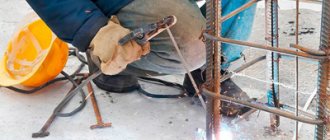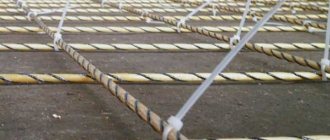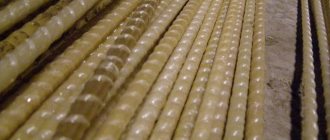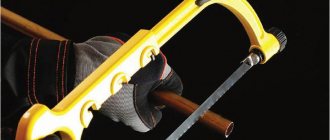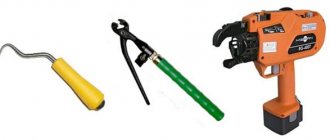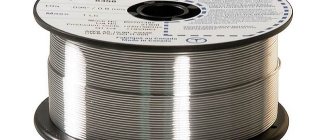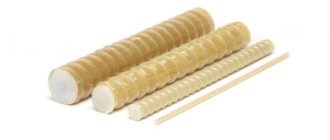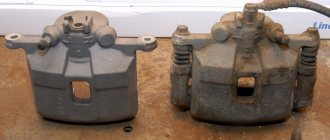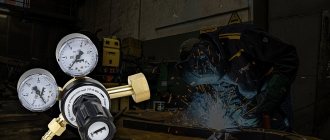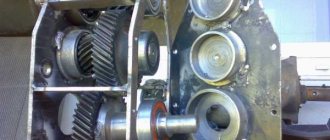The foundation is the foundation of a structure that supports the main load. For this reason, it needs to be built from durable materials with good wear and tear. Particular attention should be paid to the fastening elements that will hold the structure and also protect it from premature destruction. The most suitable option is fiberglass reinforcement for the foundation. This is a new material that has recently become very popular. But first, it’s worth considering its advantages and important features.
What is fiberglass reinforcement
Fiberglass reinforcement is a whole system of glued glass fibers.
A polymer composition is used as a binder. Typically, the reinforcement has the form of a rod, which has several constituent elements:
- main trunk It has a core that consists of parallel fibers. They are glued together using polymer resin. This ensures high structural strength;
- outer shell. The sheath fibers are wound around the AKS barrel in a spiral sequence. Sometimes sand spraying is used.
Advantages and disadvantages
Fiberglass reinforcement is an excellent option for strengthening the foundation. This material increases its strength, increases service life and allows it to withstand high loads.
If you are thinking which reinforcement is better - fiberglass or metal, it is worth considering the important positive features of composite reinforcement over steel :
- a light weight. Compared to metal products, composite reinforcement is 9 times lighter. For this reason, you do not need to use special expensive equipment to install it;
- fiberglass elements are highly resistant to chlorine and other acidic, aggressive substances. Compared to steel products, the stability coefficient of composite products is 10 times higher;
- low level of thermal conductivity. Due to the fact that the reinforcement heats up and cools down, it does not cause destruction of the internal part of concrete structures;
- Composite products have the properties of dielectric non-conductivity and electromagnetic permeability. This means that they cannot conduct electricity and do not interfere with radio waves;
- have tensile strength. Compared to metal, it is 2-3 times higher;
- increased resistance to corrosion;
- easy transportation;
- low price. Compared to metal products, fiberglass rods are much cheaper.
Do not forget about the disadvantages of composite products:
- Fiberglass reinforcement has a low modulus of elasticity and can be easily bent. During the construction of the foundation and paths, this drawback is not noticeable. But if the products are used in the construction of floors, then this nuance should not be missed; it is important to carry out all the necessary calculations;
- The products have an insufficient level of heat resistance. You should not combine fiberglass reinforcement with concrete mortar under strong temperature changes, otherwise it may completely lose its binding properties;
- fragility. Over time, composite products wear out and begin to deteriorate; exposure to an alkaline environment also has a huge impact on rapid wear. But manufacturers, in order to increase the service life of fiberglass reinforcement, began to add rare earth metals to its composition;
- not intended for welding.
Comparison of plastic and metal fittings
So, what should you choose – composite reinforcement or metal? Obviously, the choice depends on the operating conditions and purpose of the concrete base . It is impossible to say unequivocally that one or another material is better. In each specific case, a specific material is selected that best suits the tasks.
For example, for the construction of a multi-story building, the main characteristic for the reinforcement frame of floor slabs is elasticity. In this case, the best choice is a traditional steel rod, which will not bend even under significant loads over large spans.
Comparison of characteristics.
But if you need to assemble a frame for foundations operating in conditions of high humidity (bridge supports, coastal structures), increased corrosion resistance of the reinforcement is required. The solution is to use fiberglass. Also, a fiberglass armored belt is suitable for pouring a strip foundation for a one-story individual house made of aerated concrete or foam blocks .
If we consider the cost of both materials, then we will not be able to get a clear answer as to which is cheaper.
A metal rod with a diameter of 8 mm (24 rubles/m - average prices for winter 2022 in St. Petersburg are given) will cost more than a rod of the same diameter made of composite (11 rubles/m), but you need to take into account that the strength of the metal rod lower, and 8 mm plastic reinforcement will correspond in its strength characteristics to a steel rod with a diameter of 10 mm.
Reinforcement calculation
When building a foundation with your own hands, it is important to correctly calculate the necessary materials, including fiberglass reinforcement. The calculation must be carried out in accordance with the following important nuances:
- The correct determination of the base length parameters must be carried out. When taking measurements, it is necessary to take into account the length of the internal load-bearing partition;
- it is required to calculate the length of the reinforcing rods. It should be taken into account that the reinforcing elements will be placed in several tiers;
- you need to determine the number of places with connections. Composite products are joined not by welding, but by overlap. For this reason, 100 cm is added to the area of each corner;
- Calculations must be carried out for transverse connections.
To understand exactly how the calculation of fiberglass reinforcement bars is performed, it is worth considering an example using the parameters of a house with a base size of 12x12 meters, which was made using tape technology.
During the calculation the following actions will be performed:
- the perimeter of the house is calculated. P = 2*(12+12) = 48 m;
- the total length of the reinforcement elements, which are stretched into two tiers of 4 edge bars, will be calculated as follows - D = 48 * 4 = 192 m.
- the number of jumpers must be calculated taking into account the minimum permissible run-up of 0.5 meters. In an example it looks like this, P = 48/0.5 = 96 pieces;
- Calculations of the perimeter of the frame (500x500 mm) must be carried out. Pk = (0.5+0.5)*2 = 2 m;
- calculations are made of the length of the reinforcing rings - Dk = 96 pcs * 2m = 192 m. In this case, trimming must be taken into account - 192 + 5% = 202 m;
- in the end you will need - 192 + 202 = 394 meters of product with the same profile;
- It is worth calculating the required number of clamps for knitting - X = 96 pcs * 4 = 384 pcs.
Composite reinforcement
The emergence of composite materials has formed a separate group of reinforcement profiled products made from raw materials with specified technical characteristics. The name “composite” was chosen because the final product has a complex composition of elements with different structures:
- fibers arranged according to the type of wood;
- binder resin;
- surface spraying that increases adhesion.
Reinforcement before starting work
After heat treatment, a rod with a periodic profile with a factory length of up to 100 m is obtained. This allows you to transport, store and cut the product in a convenient form.
An example of the delivery of fiberglass reinforcement to a construction site for constructing a slab foundation frame is visible in the photo:
Based on the type of material of the fibers forming the base of the rod and the connecting component, the following types of polymer reinforcement are distinguished:
- carbon composite;
- fiberglass;
- aramidocomposite;
- basalt-composite;
- combined (with one predominant type of fiber, but containing inclusions of other types throughout the structure).
The most widespread use in the manufacture of supporting structures is the use of fiberglass reinforcement. It is regulated by GOST 31938-2012 (Composite polymer reinforcement for reinforcing concrete structures).
Requirements for fiberglass
The standard establishes the manufacturing dimensions of reinforcement with a nominal cross-section ranging from Ø 4 mm to Ø 32 mm. For individual construction, fiberglass reinforcing rods with sections Ø 6 mm, Ø 8 mm and Ø 10 mm are effectively used.
At the demonstration stand of the construction store you can see samples of the products offered (photo):
An essential condition for the quality of the resulting foundation is the use of fiberglass reinforcement, which, in accordance with GOST (inspection by appearance), does not have dents, delamination, peeling of abrasive coating and other visible defects.
The ability to use fiberglass reinforcement on concrete foundations is determined by the following technical characteristics of this material:
- compressive strength is not less than 300 MPa, tensile strength is not less than 800 MPa, and transverse shear strength is more than 150 MPa;
- operating temperature (limit) no more than 60°C.
If, as a result of the calculation, the value of the tensile modulus of elasticity of the ASK grade is too small, then you need to use the AUK (carbon composite) grade, in which this indicator is at least 2.5 times higher.
Comparison with metal
A project for a foundation made of fiberglass reinforcement must take into account various factors of specific technical conditions that influence the obtained result.
The main argument for replacing steel with polymer is usually to reduce the load on the soil.
The following calculation will help you consider the answer to the question whether it is possible to use glass rods for a strip foundation.
The load on the soil foundation from a support with a perimeter of 20 m, a height of 0.5 m and a width of 0.4 m made of monolithic concrete is equal to the total mass of the concrete reinforcing frame. Let's take the reinforcement content to be 3%. Volume of concrete = 20×0.5×0.4×= 4 m³. Accordingly, the volume of required rods = 4 × 0.03 = 0.12 m³.
Mass of concrete = 4 m³ × 2000 kg/m³ = 8000 kg.
Weight of steel =0.12 m³×7850 kg/m3=942 kg.
The total weight when steel is used is =8942 kg.
If fiberglass products are taken, then their mass = 0.12 m³ × 1900 kg/m³ = 228 kg.
Rules for working with fiberglass reinforcement
In order for the composite material to protect and strengthen the foundation, it is recommended to follow important recommendations when working with it:
- Rebar cutting is done using a hot torch or bolt cutter. Sawing polymer reinforcement products with any other devices causes the formation of harmful microscopic chips;
- bending of reinforcement is allowed only in the manufacture of structural reinforcement products. This process is performed using an electric hair dryer; this tool heats the bent area to 100-1200C, and then, after taking the required shape, everything is cooled;
- the fittings should be stored in a cool, dark place, protected from sunlight;
- When unwinding coils with rods, it is recommended to take into account the degree of elasticity of the composite material. To relieve its strong tension, one end of the reinforcement must be secured for some time to the coil body using a meter-long piece of chain.
How to reinforce a foundation with fiberglass reinforcement
Fiberglass reinforcement is often used for strip foundations. It strengthens it, enhances its strength. But in order for the reinforcement process to proceed correctly, it should be approached with all responsibility.
Preparation
When using composite products for the base, it is worth preparing the necessary tools for the job:
- to take the required measurements you will need a tape measure;
- Bulgarian. This tool is needed for fitting and cutting fiberglass rods;
- personal protective equipment;
- water level;
- plastic clamps. They are necessary to connect the rods.
At the preparatory stage, you need to dig a trench. It is carried out according to the data specified in the project of the future structure. Important features of earthworks include:
- After digging the trench, it is recommended to level and compact the bottom well;
- then sand is poured in the form of a layer, its thickness should be 10-15 cm;
- the layer is watered and thoroughly compacted;
- crushed stone is poured on top of the sand with the same thickness as sand and thoroughly compacted;
- As a result, a kind of cushion of sand and crushed stone is formed at the bottom.
It is important to do everything correctly. The bottom of the trench should be perfectly flat so that after laying the fiberglass reinforcement there are no distortions. This will require the use of a water level.
Construction of formwork
For a strip foundation, formwork is required; it gives it the required shape and protects it from distortions.
It is made from boards that are connected in the form of shields. It is recommended to use nails and screws for fastening. The caps of fasteners should be located on the inside. Additionally, the structure should be strengthened with special spacers. The surface of the formwork walls is covered with polyethylene film, which is attached using a construction stapler. The use of film is desirable; it will keep the boards clean and also prevent liquid from leaking out of the concrete mixture.
On the walls of the formwork it is necessary to mark the level to which the concrete solution will be poured. It will also serve as a guide when installing a frame made of fiberglass reinforcement. To get everything right, you should use a water level.
Features of the construction of a frame made of reinforcement
After installing the formwork, reinforcement must be carried out. When constructing a frame, the following important conditions should be observed:
- since the frame is completely filled with concrete, when installing the reinforcing mesh it is important to maintain a distance of at least 5 cm from the formwork walls;
- so that the reinforcing material is not installed directly at the bottom of the trench, it is worth placing additional bricks;
- then longitudinal rods of fiberglass reinforcing material are laid on the bricks in two rows, as well as horizontal rods that are crossed;
- Many novice builders often have the question of how to knit transverse and longitudinal rods. For this purpose, plastic clamps are used;
- after this, the vertical rods are also tied. The result should be cells with dimensions of 15x15 cm.
After constructing the frame, the concrete mixture can be poured. It is recommended to pour the solution carefully; it should completely fill the space between the frame elements. Be sure to periodically pierce the concrete with a metal rod, this will eliminate air voids.
Reviews from experts advise using a level when carrying out all work. It will allow you to do everything correctly and smoothly. As a result, there will be no distortions, bends and deformations, which can lead to further problems during construction.
Video: How to knit fiberglass reinforcement
Composite reinforcement for foundations: advantages, disadvantages, application.
Fiberglass reinforcement.
Until recently, reinforcement made of metal rods was considered not only the most reliable, but also the only acceptable option for creating a strong “skeleton” of the foundations of buildings for any purpose. The material in question did not appear yesterday (there are references to the experience of its use since the late 70s). But composite reinforcement did not gain popularity, so they forgot about it in our country for a while. But in foreign countries it was actively used. Therefore, we can talk about the successful use of composite rods for reinforcing concrete structures. And judging the strength and stability of such structures is not unfounded, but based on facts.
A few myths from unscrupulous manufacturers and sellers.
Fiberglass reinforcement, although not a new material (as it turned out), is unfamiliar to most consumers. The fact that advertising positions it as an innovation is nothing to worry about. It’s worse when, taking advantage of the ignorance of potential customers, the manufacturer tries in every possible way to increase the selling price of the product, pointing out the supposedly unique properties of its composite reinforcement.
Composite reinforcement photo.
Fiberglass reinforcement area of application.
While an ordinary private developer is collecting information about it bit by bit, getting acquainted with the properties and features of its application, and large construction companies are calculating the income and expenditure side of the budget when switching to a composite instead of metal, rumors are growing and multiplying. And they require a reasoned and honest answer.
One of the most common myths can be debunked right now.
- Externally, this building material is light rods with various shades of yellow (if they are made of fiberglass) or pronounced black (provided that basalt was used). However, an attempt to make the product more attractive in appearance, namely the addition of coloring pigments of various shades, made it possible to introduce colored fittings to the market. And a myth immediately appeared: these additives do not simply color the rods, but are special components that improve the characteristics of the material . Serious manufacturers give a clear answer: color does not affect the quality of composite reinforcement.
Fiberglass reinforcement.
- In addition to improving the presentation, there is also a very noble impulse behind such experiments with color: to highlight rods of different diameters.
Reading the regulatory documentation for building materials will help you not to fall for the tricks of dishonest sellers.
Application of composite reinforcement.
Composite reinforcement is gradually gaining space from its metal counterpart in the area of laying the foundations of low-rise buildings. Glass, carbon, basalt or armide fibers are used as the basis for its production. They are bonded to each other by adding polymers.
Fiberglass reinforcement can also be produced in the form of smooth rods, but when it is supplemented with a spiral winding of glass thread, more reliable adhesion to the poured solution is ensured. So it’s better to give preference to the second option.
Experts cite a number of advantages of composite reinforcement:
- ease of transportation and use due to low weight. In addition, no welding is used during installation;
- resistance to various aggressive environments;
- corrosion resistance;
- tensile strength.
Fiberglass reinforcement.
To create a foundation, composite reinforcement of a certain diameter is required. The section is calculated individually for each object. It depends on the number of floors, the complexity of the project and a number of other reasons. It is important that, while not being inferior in strength to metal rods of the same diameter, composite reinforcement will be lighter in weight.
Composite reinforcement for foundations.
- When laying a foundation, composite rods are used in the same way as steel rods. A frame is assembled from them according to the recommendations for a certain type of base with the required pitch, and at the intersection points the reinforcement elements are fastened with ties or binding wire.
- Developers and manufacturers do not give recommendations prohibiting the use of composite reinforcement for the construction of any type of foundation. That is, if the developer wishes, any foundations for a low-rise building can be made using fiberglass reinforcement.
- But you can accurately determine in which foundations composite rods have proven themselves to be the best. We are talking about strip or column methods for buildings no more than three floors high. For those who want to build: a private house, a cottage, a bathhouse, a garage, a solid building for economic purposes.
Fiberglass reinforcement for use in the country.
- The service life of elements of non-metallic origin is quite long - 80 years according to minimum calculations. Their cost may be only slightly different from the price of conventional steel rods, but it is quite possible to save on transportation. The fittings, packed in a bay, can easily fit into the trunk of a passenger car.
- Construction conditions and technologies vary. Where reinforced concrete structures will be operated in an environment that is aggressive to metal, it makes sense to use non-metallic reinforcement.
- Composite reinforcement, selected with equal strength to a reinforced concrete frame, will create a reliable foundation. And it will last much longer (due to resistance to the destructive effects of the environment and “complete indifference” to the corrosion process).
For massive concrete buildings, the following types of fiberglass reinforcement are used:
- External . Justified in cases where concrete structures are exposed to destructive effects in an unfavorable environment. The characteristics of composite reinforcement, produced specifically for these purposes, make it possible to create a protective barrier around the structure. It is impenetrable to both air and water. This method is called continuous. Sometimes, when using it, they do the opposite. First, the frame is made, and then it is filled with concrete.
- The discrete method means that composite meshes or strips of reinforcement strengthen the base from the outside.
Fiberglass reinforcement, application features.
- Discrete reinforcement assumes that composite meshes, individual rods, or even volumetric frames created from many elements will be placed inside the structure.
- The dispersed method is somewhat simpler - crushed glass fibers are added to the total mass for pouring. The resulting material is called glass fiber reinforced concrete.
- A joint . The combined method got its name not only because of the simultaneous use of two types of reinforcement, but also because it allows a combination of fiberglass and metal rods. It is used when significant weight loads are expected on the foundation.
Diameter of composite reinforcement.
If you have never encountered such a problem before, the following information may be useful.
Fiberglass reinforcement.
- Due to its design features, metal reinforcement has several indicators that characterize the diameter: the external one is measured along the ribs protruding along the profile;
- the inner one belongs to the rod itself;
- nominal, which is expressed as an integer, is the profile number.
Fiberglass reinforcement.
- In order to carry out calculation work and when purchasing material, you need to know the nominal diameter. In the conditions available to a simple home craftsman, this indicator cannot be obtained. For those for whom solving such a problem is vital, there is one trick.
- The nominal diameter is essentially the average number between the outer and inner gauge sizes. Further, the sparser the ribs are located on the rod, the more the internal diameter approaches the nominal value.
That is, you can catch an unscrupulous seller trying to pass off the outer diameter numbers as its nominal size like this:
- you need to measure the outer diameter;
- take measurements of the internal diameter;
- compare the number given by the seller with both indicators.
If the outer diameter coincides with the nominal number according to the seller, you should buy the fittings elsewhere.
Weight of composite reinforcement.
Fiberglass reinforcement properties application.
Methods for connecting composite reinforcement.
Among the advantages of composite reinforcement listed above, one of the points indicated that its use does not involve welding. The rods are assembled into a frame by tying them together.
Plastic ties are used less frequently, but builders value tying wire more. This material is more traditional and has not yet been eradicated by new trends. It is carried out in the following ways:
- using an automatic pistol;
- using a crochet hook for construction (simple configuration);
- using a screw (motorized) construction crochet hook.
The popularity of the last two options is explained by the availability of the tool. It’s rare that anyone can afford to purchase an expensive pistol just to build one foundation. Some large companies, however, practice renting out expensive but very simplified equipment. And if such an opportunity arises, then it’s worth taking advantage of it.
Among the arguments for automating the knitting process are the following:
- It is quite obvious that mechanized labor is more effective and productive;
- Having such an “assistant” you can avoid overpaying hired workers. With its use, one person can handle the strapping on their own;
- the gun makes equally smooth and strong knots on the entire frame;
- the tool is functional at any temperature;
- A powerful battery allows you to work uninterrupted all day.
The use of fiberglass reinforcement in the foundation.
Particularly advanced models of this tool are equipped with a device that allows you to tie rods without bending close to them.
Foundation with composite reinforcement and construction in earthquake-prone areas.
- Another proof of the excellent strength characteristics of composite reinforcement can be seen in its use in other areas of construction that require withstanding significant loads: walls and floors of buildings, road surfaces, coastal structures, bridges.
- But it’s rare to find mention that composite reinforcement can withstand impressive earthquakes. About five years ago, the Kucherenko Research Institute of Building Structures studied the behavior of this material under large dynamic loads. Reinforcement with a diameter of 8 mm was tested by an “earthquake” from 5 to 10 points. With its help, prototypes of panels were reinforced, which were subjected to appropriate loads and placed on vibration platforms. The material remained intact up to magnitude nine seismic activity!
Composite reinforcement video.
Fiberglass reinforcement is a durable and easy-to-use material. Today it is a worthy replacement for metal rods, and its use for pouring foundations for low-rise construction can be considered not only justified, but also an extremely desirable action on the part of the developer. This is why there are so many positive reviews about composite reinforcement among private developers.
Recommendation: This is just a review article, from it you will learn about the use of fiberglass reinforcement in the foundation. You need to carefully study your specific situation, weigh all the pros and cons, and also calculate the difference between the cost of metal and fiberglass reinforcement. Then put on one side of the scale the cost and risks when using metal reinforcement, and on the other side of the scale the cost and risks when using fiberglass reinforcement. May you make the right choice for your situation.
